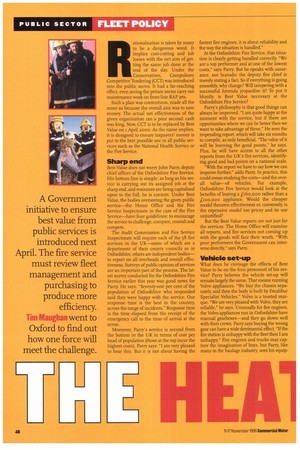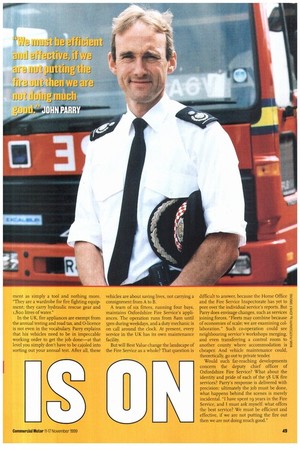A Government
Page 50

Page 51

If you've noticed an error in this article please click here to report it so we can fix it.
initiative to ensure best value from public services is
introduced next
April. The fire service
must review fleet management and
purchasing to
produce more efficiency.
Tim Maughan went to Oxford to find out
how one force will
meet the challenge. Rationalisation is taken by many to be a dangerous word. It implies cost-cutting and job losses with the net aim of getting the same job done at the end of the day. Under the Conservatives, Compulsory Competitive Tendering (CCT) was introduced into the public sector. It had a far-reaching effect, even seeing the private sector carry out maintenance work on front-line RAF jets.
Such a plan was contentious, made all the more so because the overall aim was to save money. The actual net effectiveness of the given organisation ran a poor second: cash was king. Now, CCT is to be replaced by Best Value on i April 2000. As the name implies, it is designed to ensure taxpayers' money is put to the best possible use in all public services such as the National Health Service or the Fire Service.
Sharp end
Best Value does not worry John Parry, deputy chief officer of the Oxfordshire Fire Service. His bottom line is simple: as long as his service is carrying out its assigned job at the sharp end, and resources are being capitalised upon to the full, he is content. Under Best Value, the bodies overseeing the given public service—the Home Office and the Fire Service Inspectorate in the case of the Fire Service—have four guidelines: to encourage the service to challenge, compare, consult and compete.
The Audit Commission and Fire Service Inspectorate will require each of the 58 fire services in the UK—some of which are a department of their county councils as in Oxfordshire, others are independent bodies— to report on all overheads and overall effectiveness. Surveys of public opinion of services are an important part of the process. The latest survey conducted for the Oxfordshire Fire Service earlier this year was good news for Parry. He says: "Seventy-one per cent of the population of Oxfordshire who responded said they were happy with the service. Our response time is the best in the country, across the range of incidents." Response time is the time elapsed from the receipt of the emergency call to the time of arrival at the scene.
Moreover, Parry's service is second from the bottom in the UK in terms of cost per head of population (those at the top incur the highest costs). Parry says: " I am very pleased to hear this. But it is not about having the fastest fire engines, it is about reliability and the way the situation is handled."
At the Oxfordshire Fire Service, that situation is clearly getting handled correctly. "We are a top performer and at one of the lowest costs," says Parry. But he speaks with assurance, not bravado: the deputy fire chief is merely stating a fact. So if everything is going smoothly, why change? Will tampering with a successful formula jeopardise it? To put it bluntly, is Best Value necessary at the Oxfordshire Fire Service?
Parry's philosophy is that good things can always be improved. "I am quite happy at the moment with the service, but if there are opportunities where we can be better then we want to take advantage of these." He sees the impending report, which will take six months to compile, as only beneficial. "The value of it will be learning the good points," he says. Plus, he will have access to all the other reports from the UK's fire services, identifying good and bad points on a national scale.
"With the report we have to say how we can improve further," adds Party. In practice, this could mean studying the costs—and the overall value—of vehicles. For example, Oxfordshire Fire Service would look at the benefits of buying a D6o,000 rather than a £100,000 appliance. Would the cheaper model threaten effectiveness or, conversely, is the expensive model too pricey and its use unjustified?
But the Best Value reports are not just for the services. The Home Office will examine all reports, and fire services not coming up with the goods will face their wrath. "With poor performers the Government can intervene directly," says Parry.
Vehicle set-up
What does he envisage the effects of Best Value to be on the Goo personnel of his service? Parry believes the vehicle set-up will remain largely the same. That means running Volvo appliances. "We buy the chassis separately, and then the body is built by Fxcalibur Specialist Vehicles." Volvo is a trusted marque. "We are very pleased with Volvo, they are reliable," he says. Unusually for fire engines, the Volvo appliances run in Oxfordshire have manual gearboxes—and they go down well with their crews. Parry says buying the wrong gear can have a wide detrimental effect. "If the fire station is unhappy with the fleet then I am unhappy." Fire engines and trucks may capture the imagination of boys, but Parry, like many in the haulage industry, sees his equip ment as simply a too/ and nothing more. "They are a wardrobe for fire fighting equip. ment; they carry hydraulic rescue gear and 1,8o o litres of water."
In the UK, fire appliances are exempt from the annual testing and road tax, and 0-licence is not even in the vocabulary. Parry explains that his vehicles need to be in impeccable working order to get the job done—at that level you simply don't have to be cajoled into sorting out your annual test. After all, these vehicles are about saving lives, not carrying a consignment from A to B.
A team of six fitters, running four bays, maintains Oxfordshire Fire Service's appli. ances. The operation runs from Sam until 5pm during weekdays, and a duty mechanic is on call around the clock. At present, every service in the UK has its own maintenance facility
But will Best Value change the landscape of the Fire Service as a whole? That question is
difficult to answer, because the Home Office g and the Fire Service Inspectorate has yet to A pore over the individual service's reports. But Parry does envisage changes, such as services joining forces. "Fleets may combine because 2. of economies of scale; we are examining colTklaboration." Such co-operation could see neighbouring service's workshops merging, and even transferring a control room to t another county where accommodation is cheaper. And vehicle maintenance could, theoretically, go out to private tender.
Would such far-reaching developments concern the deputy chief officer of Oxfordshire Fire Service? What about the identity and pride of each of the 58 UK fire services? Parry's response is delivered with precision: ultimately the job must be done, what happens behind the scenes is merely incidental. "I have spent T9 years in the Fire Service, and I must ask myself: what offers the best service? We must be efficient and effective, if we are not putting the fire out then we are not doing much good."












































































































